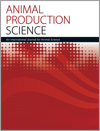
Animal Production Science
Volume 61 Number 12 2021
AN19511Leg health of meat chickens: impact on welfare, consumer behaviour, and the role of environmental enrichment
Today’s consumer values the welfare of livestock grown for food production. For chicken meat production, bird leg health is a common welfare concern. This review explores the role of animal welfare in the context of meat chicken production and consumer attitudes and behaviour. The manifestation and assessment of compromised leg health and opportunities to improve meat chicken leg health and welfare are discussed. In particular, the emerging role of enrichment in the commercial housing environment – including the use of perches and their effect on the leg health of meat chickens – is discussed.
AN19511 Abstract | AN19511 Full Text | AN19511PDF (885 KB) Open Access Article
Addition of feed additives (tannins or medium chain fatty acids) to the diet of beef calves during transition from milk and grass to a high-concentrate ration has unclear effects. Abrupt inclusion of concentrates does not always result in acidosis, but strongly changes the bacterial population, which quickly adapts to the new rumen environment. In these conditions, tannins or a mixture of medium-chain fatty acids do not seem to exert a beneficial effect on animal performance or bacterial community.
An understanding of pastoralists’ interactions with the market economy is crucial in guiding interventions aimed at enhancing market integration. This study contributes to this understanding by highlighting emerging livestock production and marketing practices adopted by pastoralists in response to market requirements. The study supports the paradigm shift in understanding pastoralists as those who are ‘non-responsive’ to market demands to those who fully engage market opportunities.
Although the growing importance of animal welfare, including consumer demands for products that have been produced with respect to the welfare of the animals, there are few studies on sheep welfare in Brazil. The main characteristics that reduce sheep welfare in Brazilian farms are low body condition scores, lesions to the legs, and pain induced by tail docking. These results may facilitate further studies and the implementation of permanent monitoring and action plans to advance sheep welfare in Brazil.
AN20135Sustainability of beef production from brigalow lands after cultivation and mining. 1. Sown pasture growth and carrying capacity
 , Jeffrey F. Clewett
, Jeffrey F. Clewett  , Alice R. Melland
, Alice R. Melland  , Tom Newsome, Jochen Eberhard, John McL Bennett
, Tom Newsome, Jochen Eberhard, John McL Bennett  and Craig P. Baillie
and Craig P. Baillie
Little information existed on the long-term productivity of pastures sown for beef production on rehabilitated mining land compared with lands retired from cultivation in southern Queensland, Australia. The present study measured the growth and quality of these pastures and employed the results in a pasture growth model using 60 years of historical weather to project their productivity and sustainability under grazing. Rehabilitated land proved to be as productive as surrounding unmined land, with results now available to guide plans for better management of grazing lands.
AN20135 Abstract | AN20135 Full Text | AN20135PDF (595 KB) Open Access Article
AN20137Sustainability of beef production from brigalow lands after cultivation and mining. 2. Acland Grazing Trial pasture and cattle performance
 , Tom Newsome, Colin J. Paton
, Tom Newsome, Colin J. Paton  , Jeffrey F. Clewett
, Jeffrey F. Clewett  , John McL Bennett
, John McL Bennett  , Jochen Eberhard and Craig P. Baillie
, Jochen Eberhard and Craig P. Baillie
Agricultural land used for open-cut coal mining in Queensland is required by law to be returned to a safe, stable and self-sustaining state for agriculture but few successful examples have been published. This research compared the performance of cattle grazing subtropical pasture sown onto unmined land with land rehabilitated after mining. Five years of observations showed that the rehabilitated pastures were no less productive than the unmined pasture, and suggested that a viable grazing system was achievable on rehabilitated brigalow land.
AN20137 Abstract | AN20137 Full Text | AN20137PDF (1.1 MB) Open Access Article
AN20134Sustainability of beef production from brigalow lands after cultivation and mining. 3. Pasture rundown, climate and grazing pressure effects
 , Tom Newsome, Colin J. Paton
, Tom Newsome, Colin J. Paton  , Alice R. Melland
, Alice R. Melland  , Jochen E. Eberhard, John McL Bennett
, Jochen E. Eberhard, John McL Bennett  and Craig P. Baillie
and Craig P. Baillie
Sustainable production is essential in agriculture and required for land rehabilitation. Field studies, modelling and simulation analysis showed that pasture growth, beef production and economic returns from rehabilitated lands after open-cut coal mining at Acland in southern Queensland were equal to or greater than those from unmined nearby lands retired from cultivation. Effects of land type, pasture rundown, climate variability and grazing pressure on outcomes were quantified to identify grazing management practices that help reduce risks of overgrazing.
AN20134 Abstract | AN20134 Full Text | AN20134PDF (881 KB) Open Access Article



